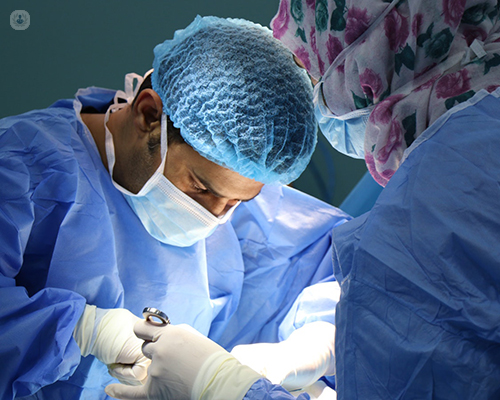Laparoscopic keyhole surgery: a comprehensive patient guide
Autore:Laparoscopic surgery (or keyhole surgery) is a minimally invasive surgical approach to the abdomen to treat conditions such as inguinal hernia, gallbladder stones and acid reflux.
One of our top consultant surgeons Mr Gianluca Bonanomi explains everything that you need to know about the laparoscopy surgery, including the aftercare and the new frontiers and continuous evolution of the procedure.

What is laparoscopic surgery?
Contrary to the past, laparoscopic surgery avoids performing large open incisions of the abdomen to carry out the necessary surgical procedure and relies on a number of technologies to enable the repair and treatment of the target tissues or organs.
Innovative technologies include special cannulas (called trocars) to obtain access to the insufflated abdominal cavity, high definition cameras to visualise, and specific instruments to enable manipulation, cutting, sewing and the treatment of tissues.
Advanced laparoscopic surgery entails a steep learning curve and requires specific training for the surgeon, anaesthetist and theatre staff.
What are the applications of laparoscopic surgery?
Laparoscopic surgery can be applied to many surgical conditions. Nowadays, most diseases requiring surgical treatment can be dealt with minimally invasive keyhole surgical techniques.
For example, laparoscopic surgery is available for the treatment of inguinal hernia, gallbladder stones, acid reflux and hiatal hernia, morbid obesity and upper gastrointestinal diseases.
Appropriate assessment and case selection are necessary to ensure the best possible outcomes. Laparoscopic surgery is sometimes not possible or contraindicated. The pathway for most patients will require an initial surgical consultation, a number of investigations as needed, a multidisciplinary team discussion for certain conditions and a preoperative assessment for anaesthesia and surgery.
What are the advantages of laparoscopic keyhole surgery?
Laparoscopic surgery enables the completion of the procedure with less trauma for the human body and a more targeted approach to the diseased tissue or organ. Generally, the advantages include a faster recovery, reduced postoperative pain, earlier discharge from hospital and resumption of normal activities.
Many studies have demonstrated that the outcomes of laparoscopic surgery are equal or superior to those of traditional open surgery.
What instructions are given to the patient when discharged home?
Many procedures are performed as a day case and the patient can be discharged the same day when stable and comfortable.
Even major gastrointestinal or bariatric surgery requires no more than two or three days of hospital stay.
Early return to normal activities is encouraged and the patient is advised to avoid heavy lifting or strenuous exercise for four to six weeks.
Depending on the type and extent of the procedure the patient will have two to six small incisions (5mm to 12mm in size). The incisions are closed with skin absorbable sutures that do not require removal or skin metallic staples that need removal after 10 days.
The patient can shower normally but should avoid bathing for two weeks after surgery until when the incisions are completely healed.
Pain killers and laxatives are generally prescribed to take home. It is not uncommon to experience constipation after surgery and the patient is encouraged to drink plenty of fluids and to take laxatives as needed. Specific instructions and medications are given to the patient depending on the type of surgery.
Generally, a follow-up consultation is booked with the surgeon after two to four weeks.
What are the new frontiers of laparoscopic surgery?
Laparoscopic surgery and minimally invasive techniques are in continuous evolution. As new technologies and knowledge are acquired, surgeons are able to improve and refine the way they treat patients and perform surgery. Modern surgery has evolved very quickly over the past two decades and the time of invasive and traumatic surgery requiring long hospital stay and lengthy recovery has long gone.
The future of surgery holds further advances with the application of robotics, artificial intelligence and regenerative medicine. Surgical treatments are becoming more personalised, targeted, less invasive and more effective.
It is the duty of the modern surgeon to keep up to date with new technologies, to ensure appropriate training and experience, to provide the patient with honest and knowledgeable information about options, risks, benefits and outcomes of each type of surgery.
If you need specific information or answers regarding the application of laparoscopic surgery and minimally invasive techniques to your medical condition, you can seek free expert advice with Mr Bonanomi by email and sending a message through his Top Doctor's profile.


